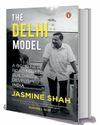
Two decades ago, sitting next to a burger-chomping carpenter going on a vacation on a low-cost flight in the US, Captain G.R. Gopinath had an epiphany—like the carpenter, why can’t ‘everyone’ fly in India as well? It is the ‘eureka’ moment the aviation pioneer credits to his decision to start India’s first low-cost airline, Air Deccan. The rest is chequered history.
Less known is that it was not his only eureka moment. Just before Air Deccan was born, Gopinath had to take a low-cost flight from London which was not flying from Heathrow, but a less known small airport called Luton. “That’s when I realised that London had six airports and all were international!” he said. Luton, the smallest among them, carried roughly the same number of passengers travelling through all of India’s 40 or so airports at that time.
Fast forward to today, India’s air traffic is hovering close to its pre-pandemic high of 14 crore passengers a year. That may sound impressive when you compare it with the 1.3 crore back in 2002. But it is cold comfort when you compare it with some other statistics. Brazil has a population of 21 crore, but its air passenger numbers just before Covid was 10 crore. Malaysia has a population of three crore, and nearly two crore annual air travellers. Ireland’s population is just half a crore, but it sold four crore flight tickets a year before the pandemic. China, which has a population comparable with India, had a high of nearly 66 crore passengers pre-Covid.
هذه القصة مأخوذة من طبعة July 17, 2022 من THE WEEK India.
ابدأ النسخة التجريبية المجانية من Magzter GOLD لمدة 7 أيام للوصول إلى آلاف القصص المتميزة المنسقة وأكثر من 9,000 مجلة وصحيفة.
بالفعل مشترك ? تسجيل الدخول
هذه القصة مأخوذة من طبعة July 17, 2022 من THE WEEK India.
ابدأ النسخة التجريبية المجانية من Magzter GOLD لمدة 7 أيام للوصول إلى آلاف القصص المتميزة المنسقة وأكثر من 9,000 مجلة وصحيفة.
بالفعل مشترك? تسجيل الدخول

Forging the future
As the curtain falls on 2024, I take pride in the extraordinary milestones achieved under the leadership of Prime Minister Narendra Modi. This year stands as a testament to the Modi government's resolve to forge a resilient and forward-looking Bharat. From groundbreaking advancements in infrastructure to visionary global initiatives, these efforts resonate deeply with the vision of Viksit Bharat.

Our strange democracy
Abraham Lincoln is lauded as among the very best presidents the US ever had: the statesman par excellence successfully steered the nation through the devastating and perilous years of the American civil war. Not only did Lincoln manage to keep his country united, he also ensured the passage of the 13th amendment to the US constitution, which abolished slavery.

Five years of post-pandemic fashion
It has been five years since we discovered what Covid-19 was, and five years since it disrupted the world forever. The World Health Organization activated their emergency systems on January 1, 2020, and informed the world by January 4, 2020. By the end of that week, they had set guidelines for various countries to follow. Comparable to the Spanish flu of 1918, more than 7 million people have died of Covid according to official data. Unofficially, no one has an idea. WHO has just this week asked China to provide critical data to understand the virus's origins as a “moral and scientific imperative”.

Community spirit
Rhythm of Dammam opens a window to the world of African-origin Siddis of Uttara Kannada

'Breaking' down a scandal
Society Girl is not just a case study of a high-profile death in Pakistan but also a stark commentary on media trials

Progress card
Jasmine Shah's book tells you what the AAP has achieved in Delhi in the last 10 years

SENSE IN NONSENSE
In his latest book of poetry, Ruskin Bond is at his funniest

Get ready for Trump bump
The ‘butterfly effect’ is a beautiful, mysterious metaphor of the planet’s interconnectedness.

QUIET FLOWS THE FAITH
The melding of an ancient amorphous faith and the latest science; of an antique tradition and new practices; ways of life older than memory and new expressions is happening at Prayagraj in Uttar Pradesh.

Trash to treasure
How a weed-choked Dal Lake spurred Maninder Singh's journey to become a waste management visionary